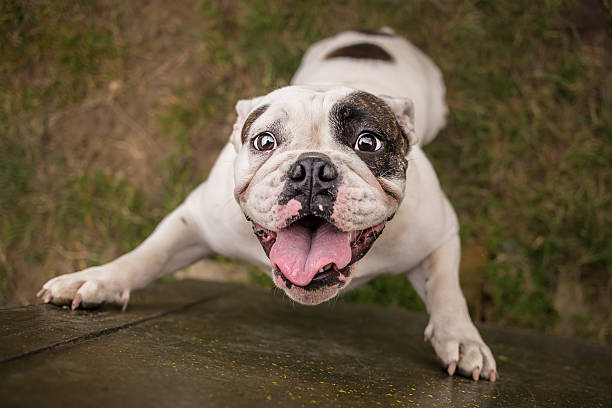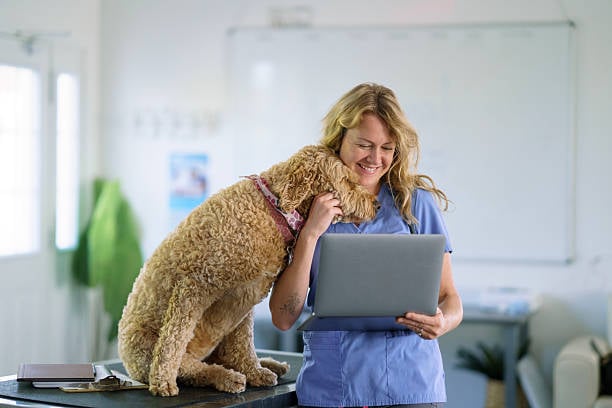As a dog daycare or boarding facility owner or staff member, you play a crucial role in ensuring the well-being and happiness of the dogs in your care. One key element of this role is understanding and addressing various dog behaviors that may arise in a daycare setting, as well as taking proactive steps to prevent issues.
Let’s review common dog daycare behavior issues and how to handle them effectively to create a safe and enjoyable environment for all.
Why do dog boarding behavior issues happen?
To prevent and address dog behavior issues, it’s important to understand the root cause behind them. The following factors can cause or worsen behavioral issues:

- A lack of socialization
- Health issues that cause physical discomfort or pain
- Environmental triggers or stress-inducing changes (e.g., a cross-country move)
- A lack of enrichment or exercise, leading to boredom
- Owners reinforcing or ignoring undesirable behaviors
- Genetics or innate drives (e.g., nipping, barking, or chasing from herding breeds like Border Collies)
Behavioral issues can range in severity, and so can their consequences. As a pet-care service provider, it should be your goal to reduce behaviors that negatively impact any of your pets’ health, safety, comfort, or overall well-being—this means taking everything from resource guarding to separation anxiety seriously.
5 Common Dog Daycare Behavior Issues
If one thing is true about working with animals, it’s that it’s unpredictable. You can never truly know what each day will hold or how the animals in your care will react, which is why it’s so important to have detailed plans and procedures in place. This way, your team can address adverse behaviors quickly and easily, even when you’re slammed on the weekends or during the summertime.
1. Overexcitement
Dogs may become overexcited when they arrive at daycare or interact with other dogs. This behavior can manifest as excessive barking, jumping, or even nipping.
How to Handle It
- Teach the dog to calm down upon arrival. For example, ask the dog to sit and reward them with praise or treats.
- Encourage play with appropriate toys and engage in activities to help release pent-up energy.
- Use time-outs to give the dog an opportunity to calm down. Temporarily separate the dog from others until they are more relaxed.
2. Resource Guarding
Resource guarding occurs when a dog becomes protective of food, toys, or even people. This behavior can lead to growling, snapping, or biting.
How to Handle It
- Avoid putting high-value items, like treats or favored toys, in common areas to reduce the risk of resource guarding.
- Supervise dogs closely during feeding time, and if possible, feed dogs in separate spaces.
- Reinforce positive behaviors such as sharing and taking turns with toys.
- If a dog exhibits resource guarding, intervene quickly and calmly, using redirection techniques to refocus the dog's attention.
3. Fear and Anxiety
New environments and unfamiliar dogs can cause fear and anxiety in some dogs. These feelings can lead to cowering, shaking, or trying to escape.
How to Handle It
- Create a calm, welcoming environment by playing soft music and providing comfortable bedding and hiding spots.
- Gradually introduce new dogs to the daycare environment and give them time to adjust.
- Be patient and use positive reinforcement to encourage socialization.
- Monitor the dog's progress and consider enlisting the help of a professional dog trainer if anxiety persists.
4. Dominance and Bullying
Some dogs may attempt to establish dominance or bully other dogs, leading to scuffles or fights.
How to Handle It
- Proactively identify dominant or bullying behaviors, such as excessive mounting, body blocking, or relentless chasing.
- Establish clear boundaries and intervene when necessary.
- Use positive reinforcement to encourage appropriate social behavior.
- To minimize conflicts, consider creating separate playgroups based on size, temperament, or play style.
5. Separation Anxiety
Dogs with separation anxiety may become distressed when their owners leave, leading to excessive barking, whining, or destructive behavior.
How to Handle It
- Encourage owners to establish a consistent drop-off routine to reduce stress.
- Offer plenty of distractions, such as toys and puzzles, to occupy the dog's mind.
- Provide a comfortable and familiar environment, including items from home like a blanket or bed.
- Offer positive reinforcement when the dog engages in independent play or displays calm behavior.
Proactive Strategies to Mitigate Behavior Issues
Looking forward, your daycare or boarding facility can also cut down on behavioral issues and incidents by using these proactive strategies:

- Conduct thorough temperament tests. A temperament test is designed to evaluate a dog’s physical and mental characteristics, as well as their reactions to external stimuli like other dogs and people. Assessing dogs’ temperaments before accepting them into your facility can help you group them accordingly, accommodate any special needs, and plan ways to correct undesirable behaviors.
- Get staff on the same page. Develop a defined, documented training process for new staff members. Onboarding should cover procedures for managing specific behaviors or incidents and what team members can do to prevent problems (e.g., separating resource-guarding dogs during meal times). Regularly review these procedures, discuss practice scenarios, and answer your team’s questions.
- Implement structured rest periods. Almost every dog can benefit from some sort of break. This quiet time keeps them from becoming overstimulated, decreasing the chance of issues arising from overexcitement or fatigue. Bake rest periods into your daily schedules, giving dogs time to relax in quiet areas away from play groups.
Additionally, be sure to establish clear lines of communication with pet parents. In addition to sharing booking reminders or marketing emails, engage pet parents in collaborative conversations about their pet. Share your own observations about their pets’ behaviors or progress, and encourage them to pass along any observations or changes they make at home.
Additional Resources
Understanding and addressing common dog daycare behaviors is essential for ensuring a safe, enjoyable, and nurturing environment. By implementing these strategies, you can create a positive experience for the dogs in your care and help them thrive in the daycare setting.
For more dog daycare management tips, explore these resources:
- Learn Industry Secrets with This Dog Marketing Playbook. Reach and engage more interested pet parents with these dog marketing tactics.
- The Secret to Successful Kennel Management: A Guide. Struggle with managing kennel capacity or scheduling staff? Get our expert tips in this guide.
- 12 Must-Try Dog Daycare Ideas for Happy, Healthy Pups. Keeping your daycare happy and harmonious means you need a solid rotation of enriching, exciting activities. Explore our top 12 ideas here.
Subscribe to the Gingr Blog









